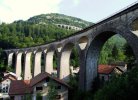(This is actually about a French viaduct but I think this forum is the best place for it).
Does anyone happen to know the English term for the pizza-slice shaped voids between the arches in the attached photo of Morez viaduct? They serve to lighten the structure - in French they are élégissement.
(Enquiry from my sister's translation forum - thanks in advance)
@timmydunn
Does anyone happen to know the English term for the pizza-slice shaped voids between the arches in the attached photo of Morez viaduct? They serve to lighten the structure - in French they are élégissement.
(Enquiry from my sister's translation forum - thanks in advance)
@timmydunn


 it may be good enough.
it may be good enough.